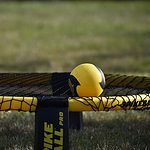As the adage goes, 'the right tool for the right job' is particularly apt when you're on the hunt for a good pickleball paddle. You're faced with myriad choices—weight, grip size, shape, core and surface materials, to name a few—all of which can significantly affect your performance on the court.
Your playing style dictates the type of paddle you need; whether you're a power player who smashes the ball or a finesse player who values control. The size of the sweet spot, the paddle's forgiveness, and even the handle length must align with your physical attributes and preferences.
Choosing the right paddle is a fine balance, one that can elevate your game to new heights or leave you struggling to keep up. As you weigh your options, consider how each feature interacts with your technique and ask yourself: what is the secret to striking that perfect balance between power and control?
Key Takeaways
- Paddle weight and grip size should be matched to your physical capability for optimal gameplay style and performance.
- Paddle shape and core material choices impact the size and location of the sweet spot, as well as weight, touch, and sound during play.
- Surface material types, such as graphite, fiberglass, and carbon fiber, influence control, power, and spin capabilities.
- Consider grip size, handle length, balance between power and control, durability of paddle materials, and the size of the sweet spot when selecting a pickleball paddle.
Assessing Paddle Weight
When selecting a pickleball paddle, carefully consider the weight as it significantly affects your gameplay style and can enhance or hinder your physical performance on the court. Paddle weights play a pivotal role in determining the balance of power and maneuverability. Heavy paddles provide a solid foundation for the power behind your shots, as the additional mass means more energy is transferred to the ball. Conversely, a lighter paddle offers greater maneuverability, allowing you to swing harder and faster but with less energy absorbed or returned.
Choosing the best weight class for your paddle is a technical decision. You must match your physical capability with the feel of the paddle. A paddle that's too heavy may strain your arm over time, while one that's too light mightn't deliver the impact you require. It's crucial to experiment with different paddle weights to discover what optimizes your control and power.
Always ensure the paddle weight complies with the regulations of your association or tournament. The optimal paddle enhances your play style, supports your physical abilities, and falls within the accepted weight class. Remember, the right balance can make all the difference in your performance on the court.
Understanding Grip Size
While assessing the weight of your pickleball paddle is crucial, equally important is selecting a grip size that ensures maximum comfort and control during play. The grip size, which is the circumference of the paddle grip, should fit comfortably in your dominant hand. To find the perfect grip size, measure from the middle crease of your palm to the tip of your ring finger. This measurement often correlates to a corresponding grip size.
Here's a quick reference table that can guide you in choosing the right grip size:
| Hand Measurement | Recommended Grip Size |
|---|---|
| Up to 4 inches | 4-inch grip |
| 4 1/8 to 4 1/4 inches | 4 1/8-inch grip |
| 4 1/4 to 4 3/8 inches | 4 1/4-inch grip |
| 4 3/8 to 4 1/2 inches | 4 1/2-inch grip |
CHOOSING A PICKLEBALL paddle with the appropriate grip size will significantly affect your ability to control the paddle throughout the game. The handle length also plays a part, allowing space for your hand between your fingertips and the base of the paddle. When holding the paddle, there should be enough room for a finger to snugly fit between your dominant palm and the fingers of your other hand. This ensures that the grip isn't too big, which might hinder your play. Remember, selecting the Right Pickleball Paddle involves careful consideration of both weight and grip.
Evaluating Paddle Shape
Assessing the shape of your pickleball paddle is key to identifying the size and location of the sweet spot, which directly influences your game's power and precision. The paddle shape determines not only the large surface area of the hitting surface but also how you manage shots during play. Keep in mind:
- Paddle Length and Width: The total length of the paddle can't exceed 17 inches, which includes the handle and hitting surface. The width of the paddle influences the sweet spot's size—a wider paddle often provides a larger sweet spot.
- Sweet Spot Placement: Paddle shape affects where the sweet spot is located. An elongated paddle may offer a higher sweet spot, which can enhance reach and power but may reduce the handle length and maneuverability.
- Edge Guard and Balance: A well-designed edge guard protects the paddle without significantly affecting the balance. Ensure that the paddle's shape maintains a comfortable weight distribution, even with the edge guard in place.
Choose a paddle shape that complements your playing style. An elongated paddle increases reach on the court, while a standard shape balances control and power. Always remember, the paddle shape should enhance your strengths and compensate for your weaknesses.
Core Material Choices
Understanding the core material of your pickleball paddle is crucial, as it directly impacts the paddle's weight, touch, and sound during play. The most popular core materials are polymer, aluminum, and Nomex composite. Polymer core paddles are known for their soft control and are relatively quiet. They provide a good balance between power and control, making them suitable for players at all levels.
Aluminum core paddles offer a lighter option with excellent touch, though they typically produce a more distinctive sound upon ball contact. The aluminum core's responsiveness is ideal for players looking to have quick reactions at the net.
Composite cores, often made from a honeycomb structure like Nomex, are durable and provide a blend of power and control. They tend to be louder than polymer or aluminum cores, which some players might find off-putting.
The core material and thickness also dictate how much energy is absorbed upon ball strike. A thicker core will generally absorb more energy, resulting in less power but increased control. Conversely, a thinner paddle core will transfer more energy to the ball, enhancing your power shots.
When choosing a paddle core, consider your playing style. Do you value control over power, or are you looking for a paddle that'll give your shots extra pop? Each core material offers distinct characteristics, so select the one that aligns with your technique and strategy.
Surface Material Types
Moving beyond the core of your paddle, the surface material also plays a pivotal role in your game, offering distinct advantages in terms of control, power, and spin. The choice of surface material types significantly influences your paddle's responsiveness and your ability to execute precise shots.
Let's delve into the most common materials used for the paddle face:
- Graphite: Graphite paddles are renowned for their lightweight and strong performance. They provide a larger sweet spot for enhanced control, making them a top choice for players who value precision.
- Fiberglass: A fiberglass face, often preferred by power players, offers flexibility. This material generally generates more power and comes with a textured surface that can greatly improve your spin capabilities.
- Carbon Fiber: If you're looking for a balance between finesse and power, a carbon fiber face should be your go-to. Similar to graphite paddles, carbon fiber offers versatility with a large sweet spot, but with added durability.
As materials and technologies evolve, you'll find paddles that combine graphite and fiberglass or introduce hybrid materials for optimized performance. Keep in mind that the paddles face material can directly impact the energy absorption/return of the ball, further enhancing your spin and overall gameplay. Choose wisely to complement your playing style.
Determining Handle Length
When selecting the handle length for your pickleball paddle, consider how it aligns with your grip style and overall playing strategy for optimal performance. The right grip size and length of the handle are crucial in determining paddle performance. Longer handles provide more reach and are beneficial if you play with two hands, especially on the backhand. Conversely, a shorter handle can enhance control and is often the right choice if you have smaller hands or prefer a one-handed backhand.
Here's a quick reference table to help you find the right handle length:
| Grip Preference | Handle Length | Advantage |
|---|---|---|
| Two-handed | Longer handle | Reach and leverage |
| One-handed | Shorter handle | Control and maneuverability |
| Mixed play | Medium handle | Balance of control and reach |
Test different grip sizes and handle lengths to determine what feels most natural and complements your playing style. Remember, while a longer handle might offer extra reach, it shouldn't compromise your ability to swiftly maneuver the paddle. Similarly, a shorter handle should not limit the versatility of your strokes. Finding the right balance is key to enhancing your game.
Balance Between Power and Control
While the right handle length is essential for grip and maneuverability, equally important is choosing a paddle that offers the ideal mix of power and control to complement your gameplay. Pickleball paddles come with different core materials and surface properties, each affecting how the ball reacts upon contact.
For an effective play, you'll need to weigh several factors:
- Core Material: The core influences the energy absorbed and released upon ball impact. A softer core typically provides more control, allowing for precise shots and better spin, while a denser core will generally translate to more power.
- Surface Texture: The paddle's surface can enhance spin, affecting control. A rougher surface grips the ball better, offering more spin and thus more control. However, too much texture may reduce the sweet spot size.
- Sweet Spot Size: A consistent sweet spot is crucial for reliable performance. Larger sweet spots tend to increase forgiveness, making it easier to hit with power and control, especially for beginners.
Strive for a paddle that balances these aspects—a forgiving sweet spot with the right core material and surface texture. This equilibrium will ensure that you aren't sacrificing too much power for control or vice versa, but rather enhancing your overall play on the court.
Importance of Sweet Spot Size
Understanding the importance of sweet spot size on your pickleball paddle is key, as it greatly affects your ability to control shots and generate power with consistency. A large sweet spot extends the area on the paddle where impact with the ball is most effective. This forgiveness ensures that even off-center hits maintain a level of precision, making for a larger and more consistent playing experience.
When searching for the perfect pickleball paddle, consider that larger sweet spots provide a more user-friendly experience. They help in reducing errors caused by mis-hits, which can be especially beneficial if you're still honing your skills. However, don't overlook the fact that tighter sweet spots can offer more power, as they concentrate the force of your swing into a smaller area. This can be advantageous for more experienced players who've refined their accuracy and are looking for that extra bit of punch in their shots.
Ultimately, the sweet spot size should match your playing style and skill level. If control is your priority, aim for a paddle with a generous sweet spot. For those seeking more power behind each shot, a paddle with a smaller, more focused sweet spot could be the best pickleball paddle for your game.
Considerations for Paddle Durability
Beyond considering sweet spot size, it's crucial to assess the durability of a pickleball paddle, as this determines how well it can withstand the rigors of frequent play. The paddle materials are fundamental to its longevity. Different materials not only affect the paddle's performance but also its resilience.
When evaluating durability, consider the following:
- Paddle Core: The core is the largest part of the paddle, dictating much of the energy absorbed during play. Popular cores include polymer, aluminum, and Nomex, each with varying degrees of durability. Polymer is renowned for its balance of strength and lightweight properties.
- Paddle Face: This is the surface that strikes the ball and is often made from composite or graphite. Graphite faces, while lightweight and responsive, can show wear more quickly than composite materials. Assess the material used for the face carefully; it should resist cracking and fading.
- Edge Guard: A robust edge guard protects the paddle's perimeter. It's a vital feature for durability, shielding the paddle from ground hits and side scrapes. Ensure the edge guard is securely attached and made of a hardy material to prolong the life of your paddle.





